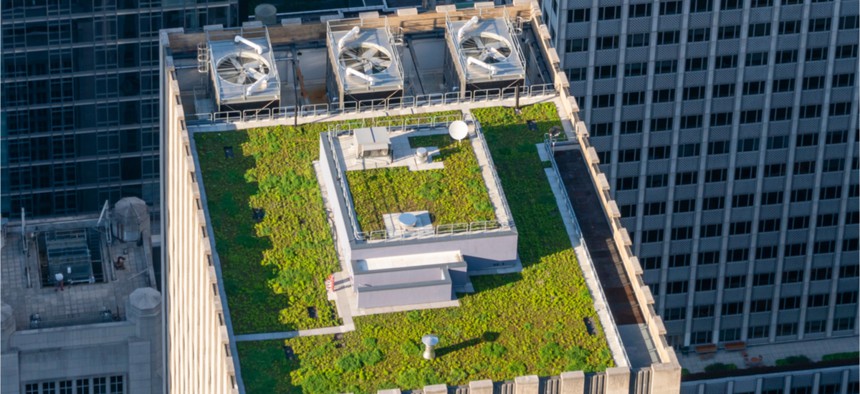Requiring Buildings Become Eco-Friendly, From the Top Down

The bill would require rooftops on new buildings to contain greenery, solar panels, small wind turbines or some combination of the three. Shutterstock
The New York City Council passed a bill that would mandate green roof space on all new and some renovated buildings.
New York City’s skyline may soon feature more greenery, courtesy of legislation recently passed by the City Council.
The measure, included in a sweeping environmental package of bills known as the Climate Mobilization Act, will require new buildings—and old structures that undergo certain renovations—to sport “sustainable roofing zones." This means roofs must have greenery, solar panels, small wind turbines or some combination of the three.
“Today, we are passing a bill that won’t just make our skyline prettier—it will also improve the quality of life for New Yorkers for generations to come,” Council Member Rafael Espinal, the bill’s main sponsor, said in a statement. So-called green roofs “cool down cities by mitigating Urban Heat Island Effect, cut energy costs, absorb air pollution, reduce storm-water runoff, promote biodiversity, and make our cities more livable for all," he said.
The bill provides exceptions for buildings less than five stories tall and requires the city to study the effects that compliance would have on affordable housing, as well as provides for a five-year phase-in to ease costs for homeowners. A related provision calls on the state legislature to increase tax abatements for green-roof installation to $15 per square foot.
Green roofs—in their simplest form, rooftops planted with greenery—are a relatively easy way for urban locations to reclaim green space and improve environmental quality. According to researchers at Michigan State University, green roofs can reduce stormwater runoff, conserve energy, and reduce noise and air pollution, among other benefits.
Green roofs have already taken root in parts of the city. Both Brooklyn Steel, a performance venue, and the Barclays Center, an indoor arena, have large green roofs that help muffle sound. In Manhattan, the roof of a mail processing and distribution center is outfitted with a 2.5-acre outdoor space for postal service employees that’s projected to last 50 years and reduce both stormwater runoff and energy usage. They are also increasingly popular among urban homeowners.
The roof provision is one of seven bills passed by the council in an effort to tackle climate change at the local level, including legislation requiring buildings with more than 25,000 square feet to cut climate emissions by 40 percent by 2030 and 80 percent by 2050.
The legislative package passed the council easily on a 45-2 vote, prompting proponents, including City Council Speaker Corey Johnson, to praise it as “the most aggressive municipal greenhouse gas emissions reduction legislation of any major U.S. city.” But some had concerns about provisions in the legislation that ease requirements for rent-controlled housing, saying this essentially would mean that low-income people won't benefit from the required improvements in housing quality.
“While these exemptions are necessary in one sense, given that state rent regulations allow some of the costs of efficiency improvements to be passed on to residents, we need a solution that addresses the outsized impacts of climate change faced by under-resourced communities,” the Energy Efficiency for All New York Coalition said in a statement. “In New York City, residents of affordable housing often live in the city’s oldest buildings, with inadequate insulation, leaky windows, and inefficient heating and cooling systems. These problems lead to unhealthy living conditions and high energy costs, and climate change will continue to make them worse.”
The legislation goes next to Mayor Bill de Blasio, who is likely to sign them into law. The mayor this week released his own environmental plan, designed to make the city carbon-neutral by 2050.
Kate Elizabeth Queram is a Staff Correspondent for Route Fifty and is based in Washington, D.C.
NEXT STORY: As ‘Raise the Age’ Plan Passes, Counties Worry About Costs





